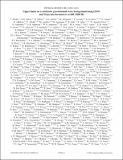Upper limits on a stochastic gravitational-wave background using LIGO and Virgo interferometers at 600–1000 Hz
Author(s)
Barsotti, Lisa; Bodiya, Timothy Paul; Corbitt, Thomas R.; Donovan, Frederick J.; Dwyer, Sheila Elizabeth; Evans, Matthew J.; Foley, Stephany; Fritschel, Peter K.; Harry, Gregory; Katsavounidis, Erotokritos; Kissel, Jeffrey S.; MacInnis, Myron E.; Mandel, Ilya; Mason, Kenneth R.; Matichard, Fabrice; Mavalvala, Nergis; Mittleman, Richard K.; Oelker, Eric Glenn; Shapiro, B.; Shoemaker, David H.; Soto, Jose M.; Stein, Andrew J.; Stein, Leo Chaim; Vaulin, Ruslan; Waldman, Samuel J.; Weiss, R.; Wipf, Christopher C.; Zucker, Michael E.; ... Show more Show less
DownloadAbadie-2012-Upper limits on a stochastic gravitational.pdf (636.6Kb)
PUBLISHER_POLICY
Publisher Policy
Article is made available in accordance with the publisher's policy and may be subject to US copyright law. Please refer to the publisher's site for terms of use.
Terms of use
Metadata
Show full item recordAbstract
A stochastic background of gravitational waves is expected to arise from a superposition of many incoherent sources of gravitational waves, of either cosmological or astrophysical origin. This background is a target for the current generation of ground-based detectors. In this article we present the first joint search for a stochastic background using data from the LIGO and Virgo interferometers. In a frequency band of 600–1000 Hz, we obtained a 95% upper limit on the amplitude of Ω[subscript GW](f)=Ω[subscript 3](f/900 Hz)3, of Ω[subscript 3]<0.32, assuming a value of the Hubble parameter of h100=0.71. These new limits are a factor of seven better than the previous best in this frequency band.
Date issued
2012-06Department
Massachusetts Institute of Technology. Department of Physics; MIT Kavli Institute for Astrophysics and Space ResearchJournal
Physical Review D
Publisher
American Physical Society
Citation
Abadie, J. et al. “Upper Limits on a Stochastic Gravitational-wave Background Using LIGO and Virgo Interferometers at 600–1000 Hz.” Physical Review D 85.12 (2012). © 2012 American Physical Society
Version: Final published version
ISSN
1550-7998
1089-4918